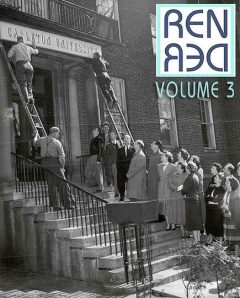RENDER – Volume Three

Acknowledgements
The third issue of RENDER would not have been possible without the enthusiasm of the faculty, staff, and students of Carleton University. I would like to specifically thank the Journal Committee, comprised of Manon Gaudet, Hannah Keating, and Rebecca Sullivan, for their sound advice and dedication during the selection and editing process. As a committee, we would like to express our appreciation for the ongoing support of the Art History Graduate Students’ Society and for Peter Coffman’s continuous guidance. It is our hope that Render will continue to be a place where graduate students can share new, valuable ideas across disciplines.
Leanne Gaudet (editor)
====================
And the Award Goes to…: The Venice Biennale and the Construction of Global Art History
by: Amy Bruce, MA Art History
This paper examines the Leone d’oro for Best Artist in the International Exhibition presented at the Venice Biennale. The purpose of this study is to question the global initiative of the Venice Biennale’s practice as one of the oldest awarding institutions. An award program has always been included in the Venice Biennale festival, with a brief hiatus from 1968 to 1986, appointing artistic relevance and preference to various artists. It would be in 1995 that the Leone d’oro for Best Artist in the International Exhibition award would be introduced. Subsequent to the development of the Leone d’oro award, there have been only two occasions when the award was given to an artist from outside of Western countries. More specifically, there is dominance for the award to be presented to artists residing in the historical art centres of Paris, New York and Berlin. By examining the curatorial themes of the international exhibition from the two years the award presented to artists from non-Western countries, my study hopes to assess the international and/or transnational construction towards a universal art history canon.
By concentrating on Leone d’oro award winners of the Venice Biennale for its historical presence and prestige of the award allows a case study for the current implementation of global art history. As studied by literary scholar James English, the symbolic meaning associated to awards demonstrates how awards could be considered tools of cultural exchange; denoting populist values and disparities. Theoretically then, the symbolic meaning conveyed to award winners at the Venice Biennale transmits an official aesthetic judgement on art practices on a world scale.
Access the full article here
Falsifying Spiritual Truths: A Case Study in Fakes and Forgeries
by: Kristyn Rolanty, MA Art History
How do allegations of forgery change the understanding of an artwork, and how does this affect its value? This essay examines the problematic nature of faked and forged artworks, focusing on a work by Ojibway artist Norval Morrisseau. The authenticity of Spirit Energy of Mother Earth (1974) has been questioned by owner Kevin Hearst, keyboardist for The Barenaked Ladies. This high profile forgery allegation examines how our understanding of the painting changes economically, aesthetically, and spiritually. Morrisseau’s work draws inspiration from the traditional knowledge and beliefs of the Ojibway peoples and he is often referred to as a shaman artist. I posit that Spirit Energy of Mother Earth declines not only in economic and aesthetic value, but also spiritually, as the forger’s work is mere imitation of Morrisseau’s artistic intent. This paper seeks to address issues of authenticity, spirituality, and intent and reveals how our engagement with a work of art is challenged when its authorship is questioned.
Access the full article here
“For a Love of His People” and Expressions of Parallel Modernities: Exploring the Framing of Horace Poolaw’s Photographs at the National Museum of the American Indian
by: Brittany Watson, MA Art History
For many Indigenous North Americans, modernity was/is not experienced as clash between tradition and modernity but rather as the continuity of culture and epistemologies used to mediate and manage their changing realities. Perhaps the most literal expressions of modernity from Indigenous peoples are those made in creative mediums such as painting, drawing, bead working, basket making, photography, and so on. In pursuant of such an expression, this paper examines the photographs of Kiowa photographer Horace Poolaw in the form of a case study, and to also look at how his images were framed in a recent exhibition at the National Museum of the American Indian in New York City (a Smithsonian Institution): “For a Love of His People: The Photography of Horace Poolaw”, curated by Tom Jones (Hochunk) and Dr. Nancy Marie Mithlo, (Chiricahua Apache). Using the theoretical framework of Susan Stanford Freidman’s “expressive dimension of modernity” and Kobena Mercer’s notion of multiple or cosmopolitan modernism, it is my assertion that Horace Poolaw’s photography speaks to a specifically Native American or Kiowa modernism, and that the exhibition successfully frames him and his photographs as participants in a broader modernity and modernist movement.
Access the full article here